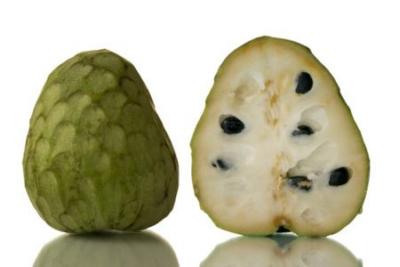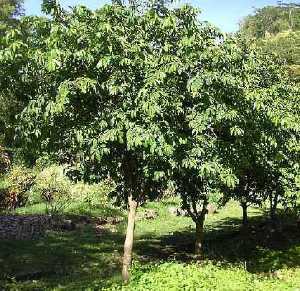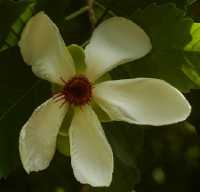 SKC Films Library SKC Films Library |
| SKC Films Library >> Agriculture >> Plant Culture >> Fruit and Fruit Culture |
| Custard Apple named for the texture of its flesh custard apples, whole and half Annona reticulata is a sub-tropical deciduous tree belonging to the Annonaceae family. Believed to be a native of the West Indies, it was carried in early times through Central America to southern Mexico. It has long been cultivated and naturalized as far south as Peru and Brazil, and is commonly grown in the Bahamas and occasionally in Bermuda and southern Florida. Introduced into tropical Africa in the early 17th century, the custard apple is now grown in South Africa as a dooryard fruit tree. The tree has also become fairly common on the east coast of Malaya, and more or less throughout southeast Asia and the Philippines. The custard apple tree is erect, with a rounded or spreading crown and trunk 10 to 14 inches thick. Height ranges from 15 to 35 feet. The ill-smelling leaves are deciduous, alternate, oblong or narrow-lanceolate, 4 to 8 inches long, 3/4 to 2 inches wide, with conspicuous veins. The flowers, which grow in drooping clusters, are fragrant, slender, with 3 outer fleshy, narrow petals 3/4 to 1-1/4 inches long. The flowers never fully open. custard apple trees custard apple flowers It takes 20 to 25 weeks for the fruit to mature. The compound fruit of the custard apple is 3-1/4 to 6-1/2 inches in diameter. The thin, tough skin is yellow or brownish when ripe. The sweet white flesh has a creamy texture similar to that of custard, hence its name. The black 1/2-inch-long seeds are slightly poisonous. The tree is naturally a fairly heavy bearer. With adequate care, a mature tree will produce 75 to 100 pounds of fruits per year. Custard apple has the advantage of cropping in late winter and spring when other members of the genus are not in season. In Central America, Mexico and the West Indies, the fruit is appreciated by all. When fully ripe it is soft to the touch and the stem and attached core can be easily pulled out. The flesh may be scooped from the skin and eaten as is or served with light cream and a sprinkling of sugar. Often it is pressed through a sieve and added to milk shakes, custards or ice cream. Custard apple is high in calorie content (100 calories per 3.5-ounce serving) but also very nutritious, providing significant amounts of vitamins C, A and B6, copper, potassium, calcium, and dietary fiber. Custard apple is said to have many medicinal benefits. Ripe fruit promotes digestion and is used as a cure for vomiting, diarrhea, dysentery and vertigo. The unripe fruit is dried and powdered and is used as a cure for treating lice. The leaves of the tree are supposed to be good for treating cancer and tumors, while the bark can relieve toothaches and gum pain. |
| SKC Films Library >> Agriculture >> Plant Culture >>
Fruit and Fruit
Culture This page was last updated on 05/23/2017. |


